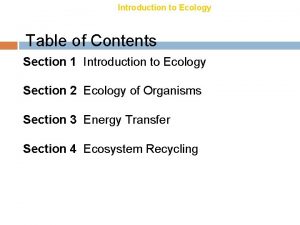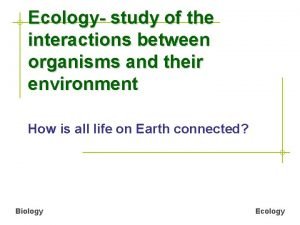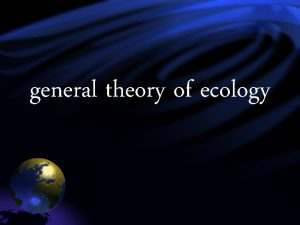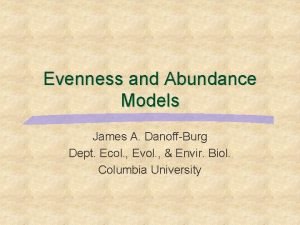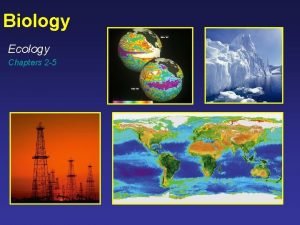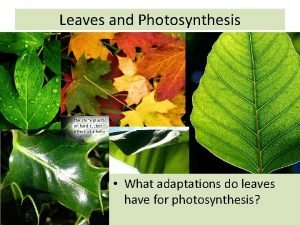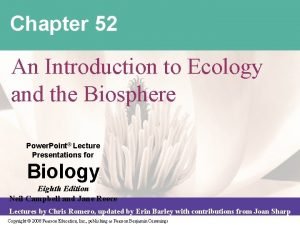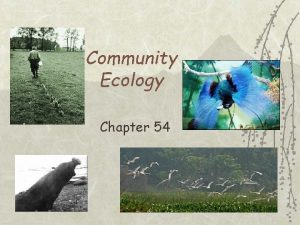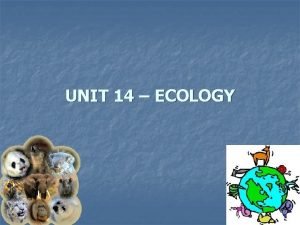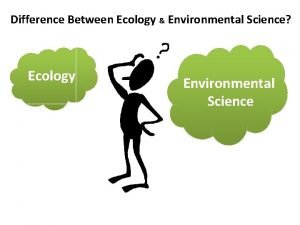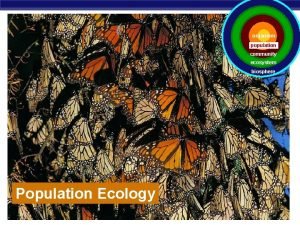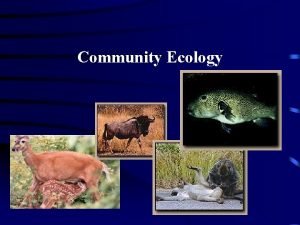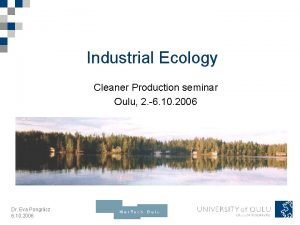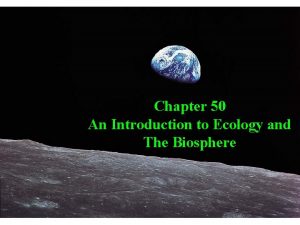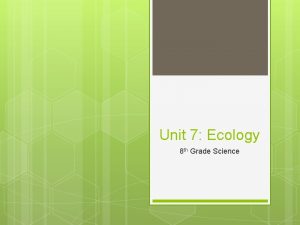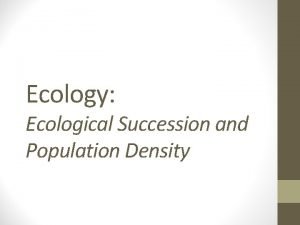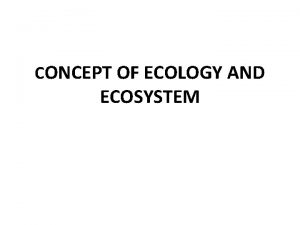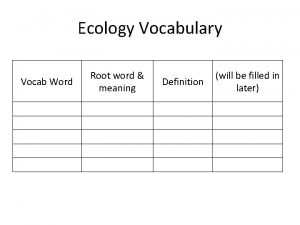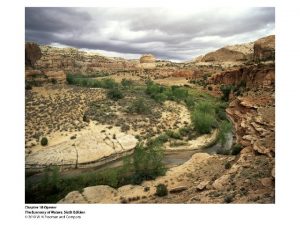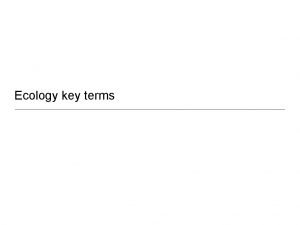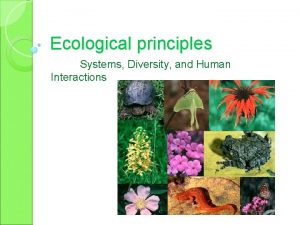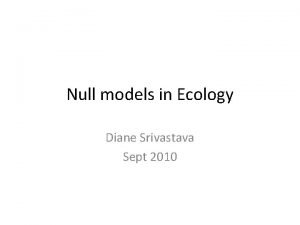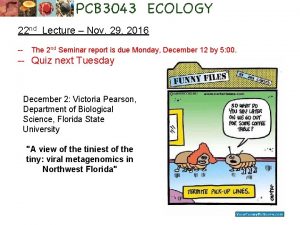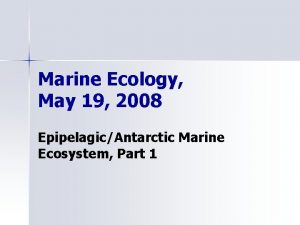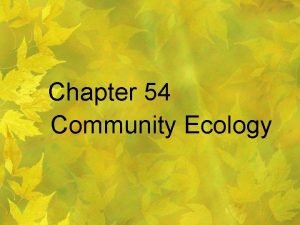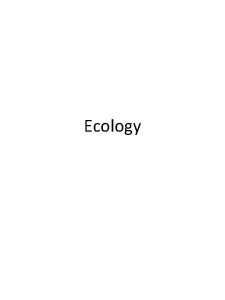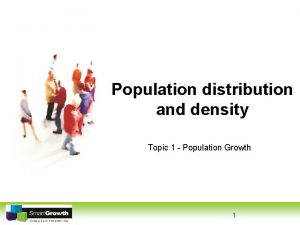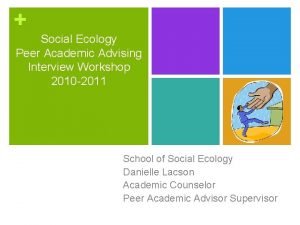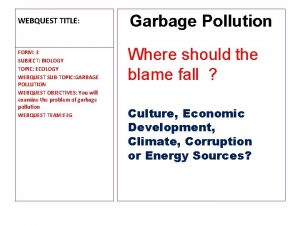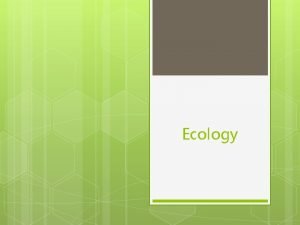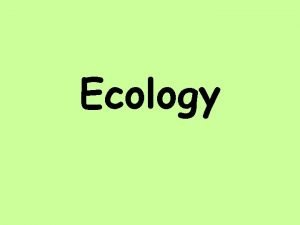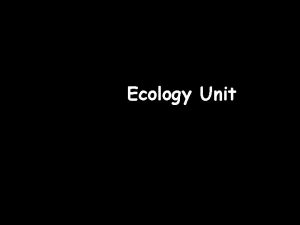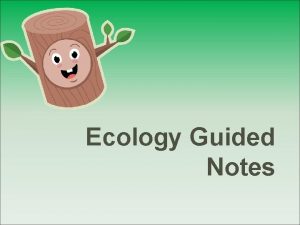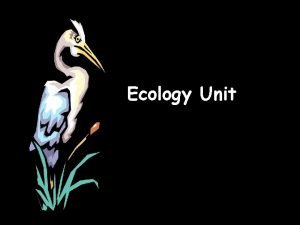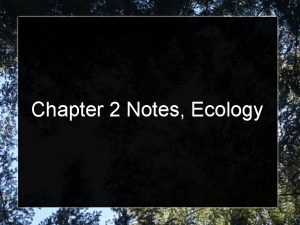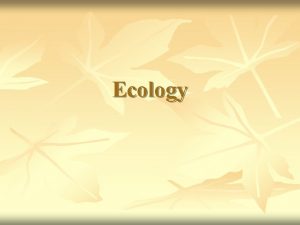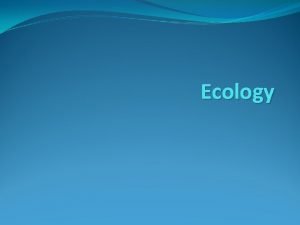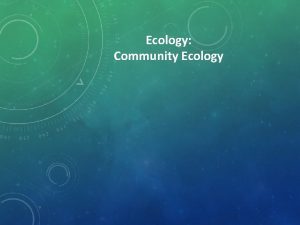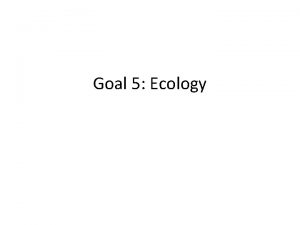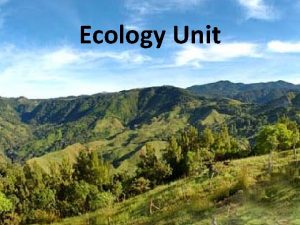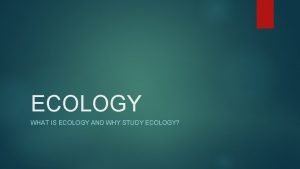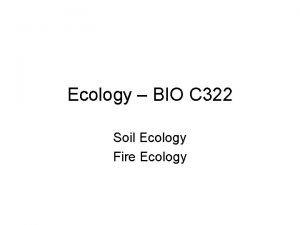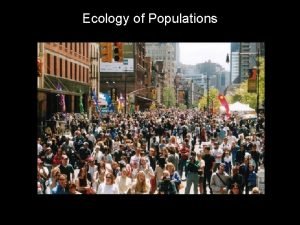Ecology Ecology Section 3 1 What is Ecology


























































- Slides: 58

Ecology

Ecology Section 3. 1 What is Ecology

Ecology The study of interactions between an organism and its environment

Two types of environments ABIOTIC ENVIRONMENT a. B. Non living environment Example: air, currents temperature, light moisture, soil BIOTIC ENVIRONMENT a. living environment b. Example: all living organisms

c. Interactions within nature are based on energy and nutrients

Levels of Organization ORGANISM n POPULATION n COMMUNITY n ECOSYSTEM n BIOME n BIOSPHERE n

ORGANISM LIVING THINGS THAT ARE MADE OF CELLS, REPRODUCES, RESPONDS, GROWS , USES ENERGY AND DEVELOPS

POPULATION A GROUP OF ORGANISMS THAT ARE OF THE SAME SPECIES AND LIVE TOGETHER IN THE SAME PLACE AT THE SAME TIME

COMMUNITY DIFFERENT POPULATIONS OF SPECIES THAT LIVE IN THE SAME PLACE AT THE SAME TIME

ECOSYSTEM POPULATIONS OF PLANTS AND ANIMALS THAT INTERACT WITH EACH OTHER AND LIVE TOGETHER

ECOSYSTEMS THERE ARE 2 MAIN TYPES OF ECOSYSTEMS TERRESTRIAL a. FORREST b. YARD c. VOLCANO SITE d. ROTTING LOG e. GARDEN AQUATIC a. POND b. LAKE c. STREAM d. OCEAN e. AQUARIUM

BIOME A GROUP OF ECOSYSTEMS THAT SHARE SIMILAR CLIMATES AND TYPICAL ORGANISMS

BIOSHPERE THE PORTION OF EARTH THAT SUPPORTS LIFE

Ecology Section 3. 2 Energy, producers, and consumers

PRIMARY PRODUCERS Primary producers are the first producers of energy-rich compounds that are later used by other organisms Examples are Autotrophs such as, algae, certain bacteria and plants

Autotrophs ORGANISMS THAT PRODUCE THEIR OWN FOOD BY USING SOLAR OR CHEMICAL ENERGY , USUALLY THROUGH PHOTOSYNTHESIS THESE ORGANISMS ARE CONSIDERED PRODUCERS

CHEMOSYNTHESIS CHEMICAL ENERGY IS USED TO PRODUCE CARBOHYDRARES OCCURS IN DEEP SEA ECOSYSTEMS WHERE THERE IS NO LIGHT. THESE ORGANISMS ARE CONSIDERED PRODUCERS AND CONTAIN CHEMICAL ENERGY FROM INORGANIC MOLECULES

CONSUMERS Consumers obtain their energy from other food sources. This can be obtained through absorption, decomposition, or consumption Examples are Heterotrophs such as, animals, fungi, and many bacteria

HETEROTROPHS ORGANISMS THAT GET THEIR FOOD FROM OTHER RESOURCES THESE ORGANISMS ARE CONSIDERED CONSUMERS

5 TYPES OF FEEDING RELATIONSHIPS HERBIVORES n CARNIVORES n OMNIVORES n SCAVENGERS n DECOMPOSERS n

HERBIVORES ORGANISMS THAT EAT PLANTS

CARNIVORES ORGANISMS THAT EAT MEAT

OMNIVORES ORGANISMS THAT EAT BOTH PLANTS AND MEAT

SCAVENGERS ORGANISMS THAT FEED ON DEAD OR DECAYING ANIMALS

DECOMPOSERS ORGANISMS THAT BREAKDOWN DEAD ORGANISMS

Ecology Section 3. 3 Energy Flow in Ecosystems

ENERGY & MATTER TRAVEL THROUGH THE ECOSYSTEM THERE ARE TWO MODELS THAT SHOW ENERGY FLOW THROUGH A SYSTEM FOOD CHAIN FOOD WEB Energy flows in a one-way stream, from primary producers to various consumers

A. FOOD CHAIN SHOWS HOW ENERGY MOVES IN A CERTAIN ORDER: AUTOTROPH---HETEROTROPH--DECOMPOSERS


FOOD CHAIN IN SOME AQUATIC FOOD CHAINS, PRIMARY PRODUCERS ARE A MIXTURE OF FLOATING ALGAE CALLED PHYTOPLANKTON.

B. FOOD WEB SHOWS ALL POSSIBLE FEEDING RELATIONSHIPS


FOOD WEB Decomposers and detrivores (organisms that digest decomposers that live on and in detrius particles (decaying remains) can release nutrients that can be used by primary producers. Example; mites, snails, shrimp, and crabs

FOOD WEB DISTURBANCES ZOOPLANKTON- SMALL ORGANISMS THAT FEED ON MARINE ALGAE. These organisms are diminishing, as a result of their habitat being compromised by the melting of sea ice caps. How does the decrease in zooplankton affect the food web?

TROPHIC LEVELS Each step in the food chain or web is called A TROPHIC LEVEL

ECOLOGICAL PYRAMIDS Shows amount of energy or matter within each trophic level. THERE ARE 3 PYRAMIDS n ENERGY PYRAMID n NUMBER PYRAMID n BIOMASS PYRAMID

ENERGY PYRAMID REPRESENTS THE ENERGY THAT IS AVAILABLE WITHIN A TROPHIC LEVEL EACH STEP DECREASES THE AMOUNT OF ENERGY BY 10 % n Energy transfers through trophic levels, in increments of 10 percent n Energy is stored in the organisms in the next level n The remaining energy is released into the environment

BIOMASS PYRAMID BIOMASS- Amount of living tissue within a given trophic level. REPRESENTS THE AMOUNT OF LIVING ORGANIC MATTER AVAILABLE AT EACH TROPHIC LEVEL IN AN ECOSYSTEM 1000 500 100 50 25

NUMBER PYRAMID SHOWS HOW EACH LEVEL REPRESENTS THE NUMBER OF ORGANISMS AT EACH TROPHIC LEVEL IN AN ECOSYSTEM 300 50 10 5

Ecology Section 3. 4 Cycles of Matter

RECYCLING IN THE BIOSPHERE Unlike the one-way flow of energy, matter recycled within and between ecosystems. Elements pass from organisms to another through closed loops called the biogeochemical cycles. Biochemical cycles are powered by the flow of energy Matter- anything that has mass and occupy space. Typically atoms and particles

RECYCLING IN THE BIOSPHERE Cycles of matter involve: Biological process Activities performed by living organisms (eating, breathing, “burning” food, and eliminating waste) Geological processes Volcanic eruptions, formation and breakdown of rock, movements of matter within and below Earth’s surface. Chemical processes Formation clouds, precipitation, flow of running water, lightning

RECYCLING IN THE BIOSPHERE Human Activity that affect the cycles of matter: • mining • Burning of fossil fuels • Clearing of land (building, farming) • Burning of forests • Manufacture and use of fertilizers

CYCLES OF NATURE THERE ARE 4 CYCLES THAT NATURE GOES THROUGH TO KEEP OUR BIOSHPERE IN LIVABLE CONDITIONS WATER CYCLE n CARBON CYCLE n PHOSPHORUS CYCLE n NITROGEN CYCLE n

WATER CYCLE Water continuously moves between the oceans, the atmosphere, and landsometimes outside living organisms and sometimes inside them n n n This cycle is made up of a few main parts: Water molecules enter the atmosphere as water vapors evaporation (transpiration) condensation (form clouds from water droplets) precipitation (rain, snow, sleet, hail groundwater, runoffs) collection (plant roots, reservoirs)

CARBON CYCLE ORGANISMS USE CARBON FOR GROWTH AND ENERGY. Carbon dioxide is exchanged between the atmosphere and the ocean (chemical and physical processes) Uses of carbon: Plants( photosynthesis-make carbohydrates) Consumers( eat plants, combine CO 2 w/ calcium and oxygen to build skeletons) Organisms release carbon dioxide(respiration) Decomposers(release CO 2 in the atmosphere When they breakdown organisms

NITROGEN CYLCE Most abundant Organisms require nitrogen to make amino acids(form DNA/RNA) N 2 = make up 78% Earth’s atmosphere Found in soil, waste products, decaying matter Ammonia NH 3 Nitrate ions NO 3 Nitrite ions NO 2 Ocean- Nitrogen is dissolved Bacteria - turn into ammonia (nitrogen fixation) - Turn nitrates into gas released in the atmosphere ( denitrification)

NITROGEN CYLCE Atmospheric nitrogen fixation- lightning converts little nitrogen into usable forms. Human contribution to the nitrogen cycle: Manufacturing and fertilizer.

PHOSPHORUS CYCLE Essential to living organisms Form DNA/RNA Not abundant in biosphere Forms inorganic phosphate Remains on land - Phosphoric rock - Soil minerals Oceans - Dissolved phosphate sediments

PHOSPHORUS CYCLE Rocks/sediments breakdown and phosphate is released. - land( soil) - Food web (producer-consumer- ecosystem) - Washes into rivers, streams

Ecology Need to Know

HABITAT WHERE AN ORGANISM LIVES OUT ITS LIFE

NICHE ALL STRATAGIES A ANIMAL USES TO FIND FOOD AND SHELTER. HOW THE ORGANISM SURVIVES

SURVIVAL RELATIONSHIPS SYMBIOSIS: THE CLOSE & PERMINANT RELATIONSHIP BETWEEN DIFFERENT SPECIES EXAMPLE: BIRDS USUALLY EAT WORMS CATS USUALLY EAT MICE SHARKS USUALLY EAT SMALLER FISH

TYPES OF SYMBIOSIS THERE ARE 3 TYPES OF SURVIVAL RELATINSHIPS n MUTUALISM n COMMENULISM n PARASITISM

MUTUALISM A SYMBIOTIC RELATIONSHIP WHERE BOTH SPECIES BENEFIT FROM EACH OTHER

COMMENSALISM A SYMBIOTIC RELATIONSHIP WHERE SPECIES A BENEFITS AND THE SPECIES B IS NOT HARMED OR BENEFITS FROM SPECIES A

PARASITISM SYMBIOTIC RELATIONSHIP WHERE A MEMBER OF ONE SPECIES BENEFITS FROM ANOTHER SPECIES BY HARMING IT
 Population ecology section 1 population dynamics
Population ecology section 1 population dynamics Main idea youtube
Main idea youtube Section 18-1 introduction to ecology worksheet answers
Section 18-1 introduction to ecology worksheet answers Population ecology section 1 population dynamics
Population ecology section 1 population dynamics Section 1 population dynamics answer key
Section 1 population dynamics answer key Section 1 organisms and their relationships
Section 1 organisms and their relationships Section 1 organisms and their relationships
Section 1 organisms and their relationships Chapter 2 principles of ecology answers
Chapter 2 principles of ecology answers Section 1 population dynamics
Section 1 population dynamics Chapter 2 section 1 organisms and their relationships
Chapter 2 section 1 organisms and their relationships Chapter 2 principles of ecology answers
Chapter 2 principles of ecology answers Work and energy section 2 describing energy answer key
Work and energy section 2 describing energy answer key Revolved section drawing
Revolved section drawing Difference between revolved and removed section
Difference between revolved and removed section Full section view drawing
Full section view drawing Chapter 10 section 1 meiosis answer key
Chapter 10 section 1 meiosis answer key Ecology
Ecology Kinesis ecology
Kinesis ecology Odum definition of ecology
Odum definition of ecology Broken stick model ecology
Broken stick model ecology Example of environmental resistance
Example of environmental resistance Clumped dispersion
Clumped dispersion Behavioral ecology definition
Behavioral ecology definition Cross section of leaf
Cross section of leaf Ecology deals with
Ecology deals with Chapter 54 community ecology
Chapter 54 community ecology Microbial ecology definition
Microbial ecology definition Biotic community is another name for____
Biotic community is another name for____ Difference between ecology and environmental science
Difference between ecology and environmental science Yale industrial ecology
Yale industrial ecology Logistic growth ap bio
Logistic growth ap bio Community ecology
Community ecology Ecology ecosystem
Ecology ecosystem Intro to ecology
Intro to ecology Unit 7 ecology answer key
Unit 7 ecology answer key Ecological disturbance
Ecological disturbance Difference between ecosystem and ecology
Difference between ecosystem and ecology Decomposer root word
Decomposer root word Community definition ecology
Community definition ecology Ecology key terms
Ecology key terms Population ecology def
Population ecology def What makes up the biosphere
What makes up the biosphere Null models in ecology
Null models in ecology Folk ecology
Folk ecology Equilibrial life history
Equilibrial life history Chapter 53 population ecology
Chapter 53 population ecology Ecosystem ecology
Ecosystem ecology Chapter 5 evolution and community ecology
Chapter 5 evolution and community ecology Marine ecology
Marine ecology Chapter 54 community ecology
Chapter 54 community ecology Biosphere definition biology
Biosphere definition biology Whats a climax community
Whats a climax community Population ecology
Population ecology What does ecology mean in greek
What does ecology mean in greek Social ecology advising
Social ecology advising Ecology webquest answers
Ecology webquest answers Objective of ecology
Objective of ecology A student is studying the ecology of a playa lake
A student is studying the ecology of a playa lake Characteristics of primary succession
Characteristics of primary succession


